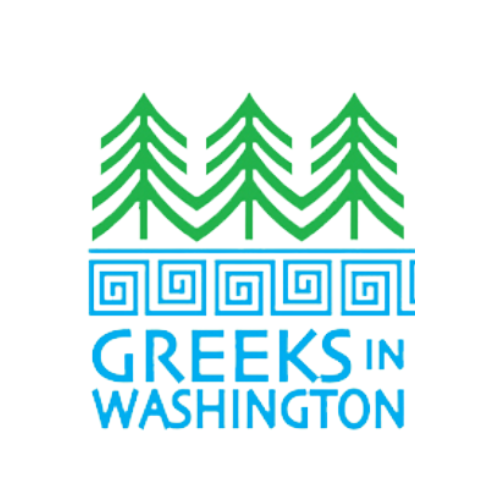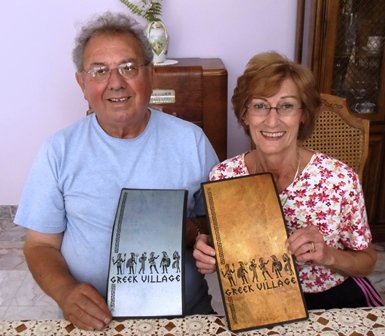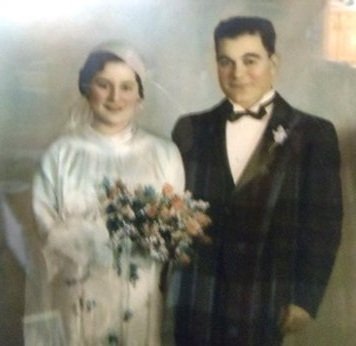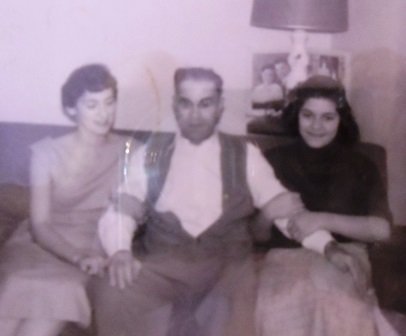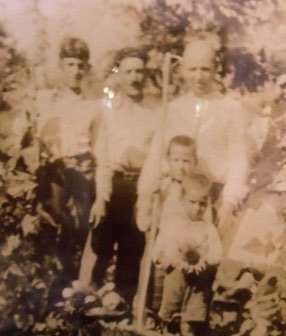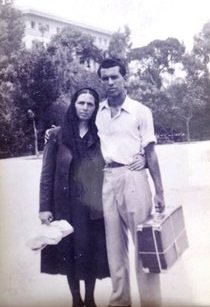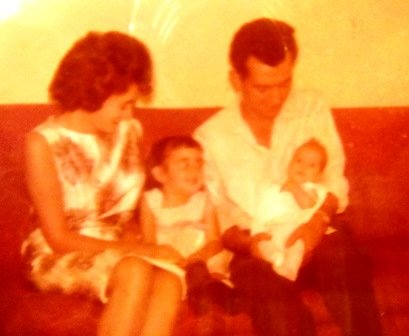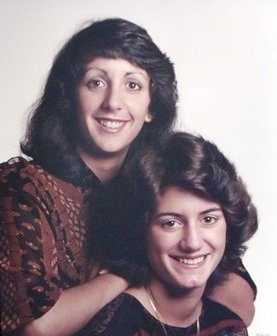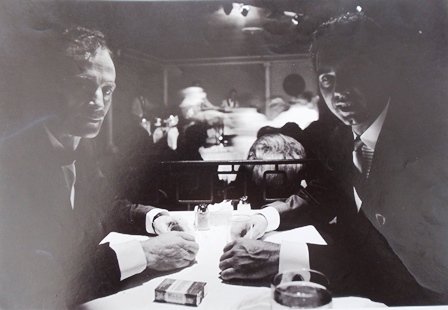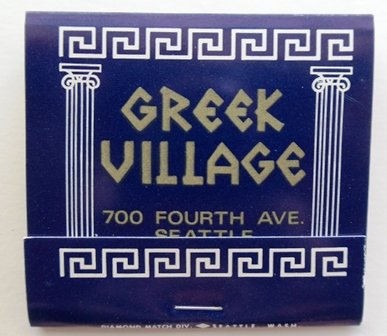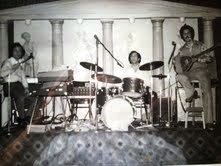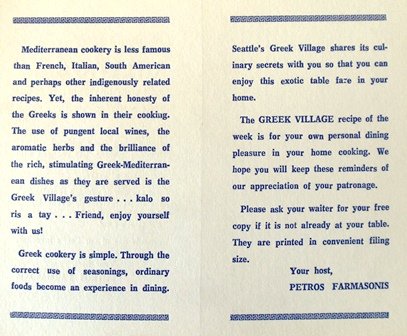A Greek Village For Two
Ask Petro Farmasonis where the best Greek food can be found in Seattle, Washington, and he will point to his own kitchen. From 1966 to 1979 Petro and Colleen Farmasonis operated Seattle’s successful Greek-themed restaurant, the Eleniko Horio, Greek Village.
COLLEEN
Epaminondas Panagioti Rockas arrived in New York in 1913 from the village of Parapoulia (now Leuctra or Lefktra) near Thebes in Greece. After a short time he traveled west and worked as a lumberjack with some other Greeks for the Snohomish Logging Company in Washington State. He also spent some time in Alaska and records show his application for citizenship in 1931. He operated the Quality Food Market on Eighth and Pike in downtown Seattle for 25 years and, after a short rest, operated the Olympic View Tavern on First and Cedar until his passing in 1957.
Annastasia Kontoyannis (Contos) was conceived in Greece and born in the United States. Her father was working on the railroad when Annastasia’s birth was imminent. Annastasia’s family settled in Spokane, Washington, where her father operated a shoeshine shop and pressed hats near the public market.
In 1934 Epaminondas attended an AHEPA (American Hellenic Educational and Progressive Association) convention in Spokane where he met Annastasia. They married in 1935 and moved to Seattle where Colleen was born on April 29, 1938. She was named after her maternal grandmother Kalomira meaning good fortune. Their second daughter, Betty Ann (Vasiliki), was born in 1941. It was all Greek at home where yiayia (grandmother) Contos frequently visited from Spokane, Washington. Annastasia’s four brothers also visited occasionally and one brother, Sam Contos, worked at the state reformatory in Monroe, Washington.
The Rockas family was one of the few Greek families living in Ballard, Seattle’s predominantly Scandinavian community. When Colleen began school at Whittier Elementary, she does not recall any language problems. She went on to Monroe Junior High School and graduated from Ballard High in 1956. Colleen also remembers attending Greek school in the basement of the Malevitsis home. Knowing the Greek language and having studied French and Latin in high school Colleen thought she might fulfill her desire to travel by working as an interpreter for the United States State Department. After further study at Edison Technical (now Seattle Central Community College) she also envisioned working for a doctor or lawyer. In 1953 the family attended the annual Greek picnic at Angle Lake, south of Seattle. There she happened to meet a young soldier, recently arrived from Greece by the name of Petro Farmasonis. As Colleen was just 15 years old at the time, a relationship was not to develop for several years. However, with her father’s help, as Colleen’s Greek was limited, she corresponded in Greek with Petro and sent him photos of them taken at the picnic. His letters to Colleen were interpreted by Epaminondas for her.
She worked for Allied Artists, a movie producing company, and then for a year as a stenographer in the public relations office at the Sand Point Naval Air Station (now Magnuson Park) in Seattle.
PETRO
Petros Nicholas Farmasonis was born on August 1, 1932, in Agia Sophia, Greece, 25 miles south of Tripoli in the Peloponnese. His parents had raised three boys and three girls in this town of 55 families.
Having lost three years of school during the German occupation, Petro was far behind when he returned to school. He hungered for education but needed to work to help the family. The family had moved to Argos where Nicholas found construction work thanks to the Marshall Plan (European Recovery Program) of economic support to help rebuild and prevent the spread of Soviet Communism. Petro’s job was to help his father stucco and paint the tiles on a new bank. Subsequently, he went to Athens and attended Merchant Marine school for two and a half years. When his father died in October of 1951, he returned home to Agia Sophia to help his family. Looking for a permanent job, Petro read about the policy declaring children eligible for emigration as orphans if they were born on or after August 1, 1932 (his birthday) and a parent was deceased. At the time he was 18 years old and had two weeks to arrange his departure or be inducted into the Greek Army. With the help of friends and relatives and long rides on his bicycle between Argos and Tripoli, he was able to secure the proper authorization. At the American Embassy in Athens, he was again able to avoid a lengthy wait to pass his physical and obtain his passport. On June 10, 1952, he boarded the ship from Piraeus to New York with about 500 youth from 8 to 21 years of age, most designated as orphans. “It was a party every night!”
In New York Petro received an envelope with $10.00 and a train ticket to Chicago, Illinois. Fortunately, as he spoke no English, a young woman passenger assisted him and several other Greeks on the trip. He stayed in Chicago with his mother’s sister for a few days and took the train to Seattle, arriving on August 2, 1952. He lived with his aunt and uncle, Nick and Helen Carras for one year and attended Edison Technical School to learn English. He didn’t really learn much as he always spoke Greek with fellow students Theme Kollias and Milton Mitalas. In February of 1953, having registered for the draft, he received his notice to report for duty. He was initially sent to Fort Lewis (now Joint Base Lewis/McChord) south of Seattle. While stationed there he attended the Greek picnic at Angle Lake and met young Colleen. His 16-week basic training at Fort Ord, California, was challenging but, having had a rigorous life in Greece, he found it fairly easy. Plus he was being paid $90.00 a month compared with $2.00 in the Greek Army.
His military service in the First Armored Division was at Fort Hood, Texas, and he spent the last three months as a life guard with Seabees who were training by building bridges. Dark-skinned to begin with and tanned from the sun, Petro came to understand racial discrimination in a tavern in Waco, Texas. Fortunately, the proprietor was Greek and was happy to serve him while other patrons looked on accusingly. By authorizing one-half of his pay to be sent to his mother in Greece, his mother’s portion was doubled by the military. As a result, relatives in Greece believed Petro to be a wealthy man. And, by working extra duty for others and forgoing vacations, he arrived back in Seattle in June of 1955 with $2,400.00 in his pocket. Proud of his savings, he was a bit chagrined when his aunt indicated that his sister’s dowry in Greece had not been paid. Petro was young, strong and optimistic and took this setback with no regrets.
PETRO AND COLLEEN
By this time, Colleen was 20 years old (and very different from the 15-year old at the picnic) and their relationship was reestablished. The couple married on August 24, 1958, at St. Demetrios Greek Orthodox Church in Seattle. Petro worked at Alexander’s foundry until he hurt his back in 1959. Then he began working for Mrs. Rockas at the Olympic View Tavern. In 1959 Colleen left her job as she was pregnant with their first child, Fotini Maria. A second daughter, Nicoletta, was born in 1962.
When Nick G. Carras opened the Hofbrau House at Fourth and Virginia in Seattle (later operated as the Trojan Horse by Louie Carras) Petro worked there until it sold to Andy Nagy in 1961. Petro then worked in the Marine Room of the Olympic Hotel (now Fairmont Olympic Hotel) as an assistant manager. Eventually, he became the Grill Room manager at the Olympic with 50 waitresses, 16 bus boys and eight cashiers. As he gained experience he also hired a number of young Greek men, including Harry Stasinos, Tom Conom and several others. When Nick G. Carras and John Chigaras bought the Top Cat tavern, Petro joined them as a partner. However, after a short time there, he was searching for something else.
In 1966 Petro opened the Greek Village in downtown Seattle wBill Apostolou. Greek culture was coming into vogue with the movie Never on Sunday and it was an opportune time to provide Greek cuisine and culture for restaurant patrons. Initially they served only lunches where the Village became a major attraction for both Greek and non-Greek customers. Colleen became the financial controller, carefully keeping the books for the Village. Her mother was the chef, giving the food an authenticity not found elsewhere in Seattle. Petro had done some travelling and was able to engage several musicians, including John Tziotis, Nick Halkias, Tony Proios and Eleftheri Retsinas. The music and belly dancing added flavor. Petro and Colleen partnered with Jim Anas for a while but it was primarily the couple that made the Greek Village what they wanted, not only a representation of Greek food, but of the entire culture of Greece. Petro and Colleen worked at making the Village “first class all the way” even introducing separate menus for men (blue with pricing) and women (gold, without pricing). After 13 years of operating a fast-moving and successful business, the couple decided it was time to sell the Village in 1979.
In 1980 Petro and Colleen opened Theo’s Pizza and Pasta in Mountlake Terrace, north of Seattle. The Greek pizza, made with French-bread dough, was standard in a number of Greek-owned pizza restaurants at the time. Petro retired in 2006 after another successful venture.
Colleen had worked in the medical field part time before the Greek Village opened. After it closed she went back to work as the surgery coordinator and scheduler for a reconstructive surgeon. Colleen enjoyed consulting with patients and, since recently retiring, would like to volunteer, perhaps at Children’s’ Hospital in Seattle just as she did during her high school years.
Petro’s retirement years find him on the golf course. He first learned the game with Pete Conom, John Lucas and George Cotronis just after he arrived in Seattle. When he sold the Greek Village, he played even more with friends Terry Karis, (see MAKING GOOD PAREA under Keeping Community) Tom Economou and Pete Conom. His friendships with Ed Wynakos, Milton Mitalas, Manuel Xenos and Theme Kollias (all deceased) remain deep in his memory as they shared the common experiences of young Greek immigrants. Currently he walks regularly and plays golf with other Greek friends.
Petro joined AHEPA in 1972 with several of his friends and was active in the association for many years. He enjoyed the company of other Greeks, learned a lot from them and attributes his success to the work ethics inherited from his ancestors. He believes that, as a Greek, he represents not just himself, but the whole country of Greece. Similarly, Colleen has been active with the Maids of Athena and Daughters of Penelope (the womens’ affiliates of AHEPA). In 1956 she proudly represented Seattle’s Greek community as “Queen of Hearts,” making her one of several young women vying for Seafair Queen in Seattle’s annual festival. She fondly remembers and misses the closeness and family characteristics of the Greek community which have diminished over the years. Petro and Colleen benefit from having their daughters and two grandsons nearby. And, while they will follow their own course in life, their grandsons are quick to share their Greek ancestry and their yiayia’s (grandmother) and papou’s (grandfather) stories with their friends.
Through his study of the United States geography and climates while in Greece, Petro had no doubt that he would succeed when he arrived in his new country. It was his American dream and he never worried about his future. His experiences have far surpassed his expectations. He believes the American dream is still there if one is willing to sacrifice and work hard. He says “God gives you two gifts: life and relatives. Both are precious. And, while those are given, everything else you have to earn.”
By John and Joann Nicon, June 2013
PHOTOS
Petro and Colleen with Greek Village menus, 2013
Epaminondas and Annastasia wedding, 1935
Colleen, Queen of Hearts, 1956
Colleen, Epaminondas and Betty Ann, 1956
Colleen, Annastasia and Betty Ann, 1983
Grandparents, Vasilios and Maria Farmasonis, pre 1900
(l-r) Vasili Farmasonis, Nicholas Farmasonis, Nick Carras, Kosta Farmasonis and Petro, circa 1938
Fotini and her son Petro when he was leaving for the United States, 1952
Petro (center) at Fort Ord, 1953
Petro and Colleen wedding, 1958
Colleen, Fotini, Petro and Nicoletta, 1962
Daughters Fotini and Nicoletta, 1970s
Bill Apostolou and Petro at Greek Village opening, 1966
Greek Village Matchbook
Greek Village Band (l-r): Nick Halkias, John Tziotis and Tony Proios, 1970s
Greek Village menu
Greek Village belly dancers, 1970s
Theo’s Pizza and Pasta logo
Colleen and Petro, 2000
Petro with family (l-r) standing: Nicoletta Farmasonis, Colleen, Petro, Vicky Kangles; seated: Efthalia Gregores, Nick Carras, Helen Carras
Petro’s culinary pledge
Photos 1, 14 , 16, 18 by John Nicon; all others from Rockas and Farmasonis family collections
SOURCES
Video interview by John and Joann Nicon, June 2013
VIDEO SEGMENTS
